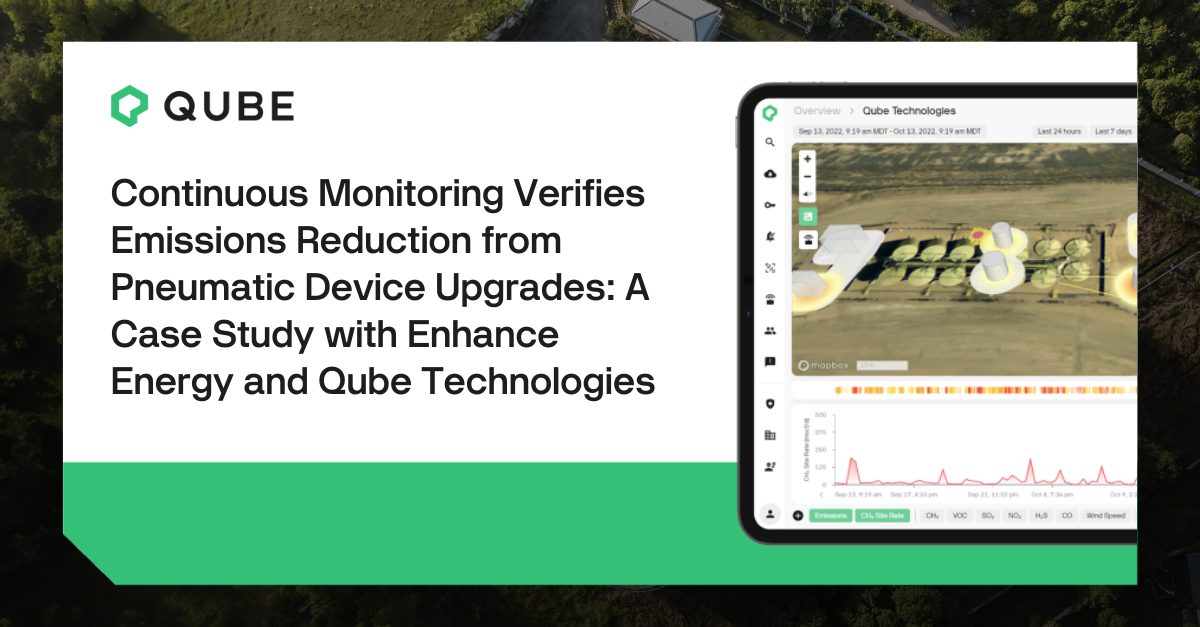Emissions Management Resources
Articles, white papers and case studies to help better understand emissions.
Case studies
Qube Technologies has built the Controlled Release Test Facility (CRTF), roughly 60 km (~ 37 mi) west of Calgary, Alberta, which functions as a specialized field environment to conduct continuous monitoring (CM) emissions tests under controlled real-world conditions.
Qube’s platform provides continuous emissions monitoring, using wind data, gas concentration, and source identification algorithms to detect methane leaks. However, users must verify alerts, as the algorithm benefits from operational input to ensure accurate source identification.
By upgrading high-bleed pneumatic devices to low-bleed controllers and implementing robust monitoring programs, operators can achieve significant reductions in methane emissions. These proactive measures are essential for complying with evolving regulations and minimizing environmental impact.
This study reinforces a core value proposition of the Qube platform: minimal sensing hardware is required to accurately quantify methane emissions, and the devices remain reliable year after year in the field without manual intervention.
Qube deployed continuous monitoring devices with CH4 and CO sensors throughout a customer’s natural gas processing facility. The Qube sensors detected elevated emissions – specifically, increased CO concentrations – and reported this data to the customer via Qube’s dashboard.
We often hear from customers how important it is for their Qube Emissions data to integrate into their existing SCADA systems. For locating and troubleshooting issues, nothing beats having a single screen with integrated data about your facility’s operations alongside the atmospheric data and emissions model results reported by the Qube system. With the Qube REST API, this is all made easy.
Emissions from oil and gas facilities are dynamic and often intermittent, meaning that standard measurement techniques may only capture a small portion of a facility's actual emissions. This is commonly known as intermittency, referring to the sporadic release of gases caused by operational changes or equipment issues.
This pilot showed that leaks do not occur at consistent intervals or emission rates. In fact, just 5% of the detected leaks represented ~55% of the total emissions over nine months of data collection. This distribution is similar to the oil and gas sector, where research has found that the top 5-10% of leaks represent 60-80% of emissions.
Qube Technologies’ continuous monitoring platform can help operators limit super-emitters events, time bound events if they do occur and avoid negative publicity and potential penalties through real-time detection, localization, and quantification of methane leaks.
Continuous monitoring technologies allow operators to implement novel operation and maintenance work practices to efficiently respond to methane emissions
One of the largest power producers in Indonesia implemented Qube‘s continuous monitoring solution to monitor for H2S gas at a new geothermal facility.
Blogs
From wrangling rattlesnakes to managing methane emissions, Andrew Walsh's journey to becoming Qube's VP of Customer Success is anything but conventional. Let's get to know the technical expert who's helping shape the future of emissions monitoring technology.
Qube’s continuous monitoring (CM) solutions set a new standard for emissions management. On-site sensors detect methane leaks in real time, even in adverse conditions. Advanced analytics quantify leak intensity and calculate emissions, allowing for targeted remediation planning.
As the year wraps up, we’re proud to highlight the incredible progress Qube Technologies has achieved this year. Here are some highlights that showcase our growth, innovation and impact
Release 2.43 enhances your Qube dashboard with smarter custom alarm notifications, offering personalized settings for alarm parameters and notification frequency. Admins can now monitor device uptime with 6-hour intervals and track performance across devices, sites, and organizations. Gas concentration trends are now easier to visualize with options to toggle between hourly and daily averages.
At Qube Technologies, listening to our customers isn’t just part of what we do—it’s central to our mission. In the critical field of emissions monitoring, understanding real-world challenges and anticipating customers’ emerging needs are key to driving innovation.
Qube’s platform offers real-time leak detection, efficient alerting, and odor management, enabling RNG operators to maximize revenue, enhance safety, and reduce emissions.
Qube Technologies remains proactive in supporting EPA compliance, offering continuous monitoring solutions with advanced tracking features. Qube has also applied to have its technology recognized as an alternative for NSPS OOOOb/EG OOOOc standards, positioning clients for seamless adaptation to changing requirements.
Qube Dashboard 2.41 release introduces integrated aerial inspection capabilities and emission plume visualization tools for enhanced environmental monitoring and compliance management.
Evolving regulations demand operator compliance to ensure efficient and cost-effective operations. Qube, a leader in continuous methane monitoring, helps clients across industries, including oil and gas, meet these regulatory challenges.
Qube Technologies has built the Controlled Release Test Facility (CRTF), roughly 60 km (~ 37 mi) west of Calgary, Alberta, which functions as a specialized field environment to conduct continuous monitoring (CM) emissions tests under controlled real-world conditions.
The landfill sector is undergoing significant change – heightened public scrutiny, incoming regulatory changes, and a rapidly evolving emissions monitoring landscape. Continuous monitoring technologies such as Qube offer clear advantages over traditional SEM approaches, including real-time leak detection, odor management, and all-season coverage.
Recently, we had the privilege of participating in the SPE Tech Talk, hosted by Victoria Jones, where our Chief Operating Officer, Eric Wen, shared insights into our cutting-edge methane sensor technology and its real-world applications.
Downloads
Qube Technologies’ continuous monitoring platform can help operators limit super-emitters events, time bound events if they do occur and avoid negative publicity and potential penalties through real-time detection, localization, and quantification of methane leaks.
Watch Taryn Humphreys from Qube Technologies discuss the efficacy of continuous monitoring systems for quantifying and localizing methane emissions
Continuous Methane Measurement: Equivalency Evaluation of Regulator-Approved Alternative Leak Detection and Repair Program in Alberta, Canada
A typical “super-emitter” in the Permian Basin is equivalent to 10,000 bbq’s (1000 kg/h)



























